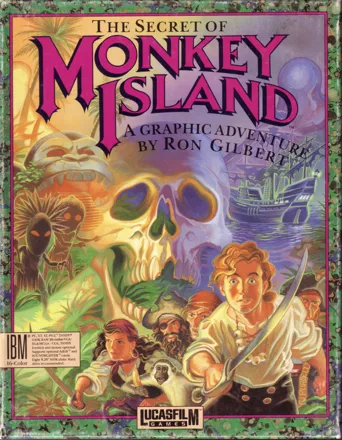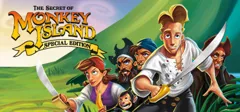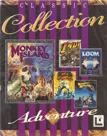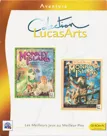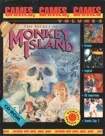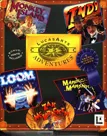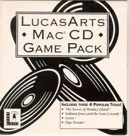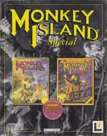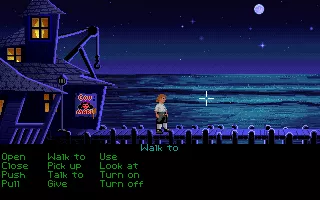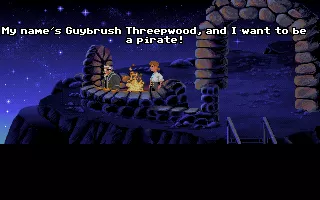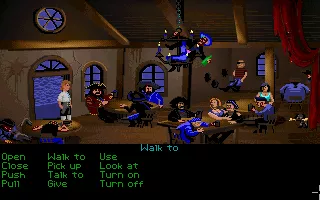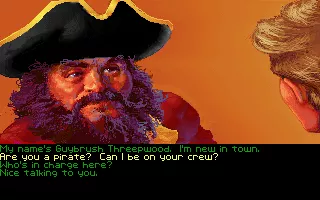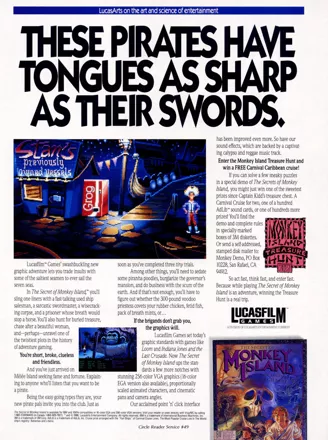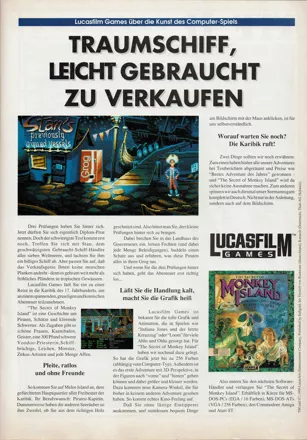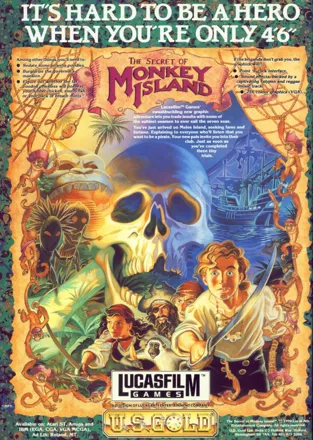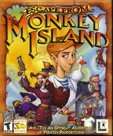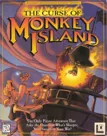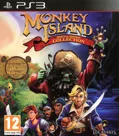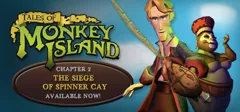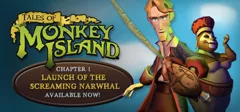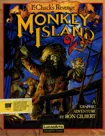The Secret of Monkey Island
-
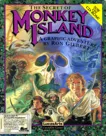 The Secret of Monkey Island
(1992 on
DOS,
Macintosh,
FM Towns)
The Secret of Monkey Island
(1992 on
DOS,
Macintosh,
FM Towns)
Description official descriptions
Deep in the Caribbean lies Melee Island, ruled by the governor Elaine Marley. The cruel pirate LeChuck is deeply in love with her - so deeply that he refuses to accept his own death. As a ghost, he dwells with his undead crew somewhere near the mysterious Monkey Island. Meanwhile, a young fellow named Guybrush Threepwood is determined to become a real pirate. At the Scumm Bar, he meets three pirates who tell him he has to complete three difficult tasks in order to be worthy of this title. But as Guybrush is trying to complete these tasks, he encounters the lovely governor, and this meeting changes his life forever. Risking to incur the wrath of LeChuck, Guybrush has to prove his wit is as sharp as his sword, and figure out a way to foil the ghost pirate's plans.
The Secret of Monkey Island is an adventure game that utilizes the command verb-based SCUMM interface first introduced in Maniac Mansion: the player constructs commands for Guybrush by selecting an appropriate verb and then combining it with an object or an inventory item. Objects that can be interacted with are highlighted when the player places a cursor over them. The game is the first LucasArts adventure in which it is impossible to get irrevocably stuck; like in Loom, the player character also cannot die. The branching dialogue system, where the player chooses between several available responses during conversations, allows the player to talk to characters in different ways without fearing a wrong choice and is often used as a humorous device.
The puzzles are predominantly inventory-based; most of the problems in the game are solved by picking up items and combining them with each other or with objects (or people) in the game world. Several tasks are dialogue-based; among those is the humorous "insult swordfighting", which involves Guybrush learning and choosing witty insults while dueling pirates.
Spellings
- モンキー・アイランド ユーレイ海賊大騒動! - Japanese spelling
- 猴島小英雄 - Chinese spelling
Groups +
Screenshots
Promos
Videos
Add Trailer or Gameplay Video +1 point
See any errors or missing info for this game?
You can submit a correction, contribute trivia, add to a game group, add a related site or alternate title.
Credits (DOS version)
85 People (83 developers, 2 thanks) · View all
| Original Concept | |
| Design | |
| Programming | |
| Interpreter / Development System | |
| Graphics / Artwork | |
| Music | |
| Producer | |
| [ full credits ] | |
Reviews
Critics
Average score: 90% (based on 50 ratings)
Players
Average score: 4.2 out of 5 (based on 619 ratings with 24 reviews)
The father of adventure games? I'm not so sure ...
The Good
It's funny and it makes you think.
That may be a cliched way to start an interview but this truly does fall under that old axiom. It will make you laugh and the puzzles will make you want to wrench out your hair (especially the shopkeepers vault one). The interface is intuitive and overall it's a class act. Very polished and nicely done. This deserves a place in any gamers collection. If there's not something in here that doesn't appeal to you then you are indeed very odd and you should pat yourself on the back for being a fine individual.
The Bad
It just isn't original. It isn't the father of adventure games nor does it do anything really special. Classy it is, funny it is but groundbreaking? It's not, the story isn't really that epic either, it's just a bunch of really well told jokes.
In my mind I'm comparing this with Loom, now there's originality in an adventure game and it's story that hasn't been matched to this day, it had an intriguing storyline and the interface was based around musical notes. Now that's ingenuity! I can't say Monkey Island even touches that.
The Bottom Line
I would describe it as a game you must have, a game you will play over and over. A game that, even if you are a comedy-movie afficianado, will appeal to you more than a good deal of videos in your collection and yet a game that does nothing breath-takingly new. It's for adventure gamers wanting more of the same and basically, anyone with a sense of humour.
DOS · by Marcus Wolf (2) · 2000
I would become a pirate just to be able to play this game
The Good
The path between Maniac Mansion and Secret of Monkey Island was not entirely thorn-free for LucasArts. They designed interesting and influential games, but were sometimes struggling to find their own tone. Eventually, their hard work and talent crystallized in what some fans consider their most important creation. Indeed, while Maniac Mansion was the one that put the company on the map, LucasArts' design philosophy and everything they stood for is firmly associated with the adventure that takes place deep in the Caribbean.
There is not so much in Secret of Monkey Island that is different, but rather a lot that is more polished and complete. All the tendencies, all the sparks of brilliance from their past titles united in this game like never before. The perfect amalgamation of puzzles, plot, visuals, and atmosphere made this happen. Secret of Monkey Island is much less revolutionary than Maniac Mansion and much less unique than Loom, but it is undeniably a more exciting game.
LucasArts was always trying to compete with Sierra, but only in this work they managed to put everything together to beat the archrival at their own game. Realizing that text descriptions and interactivity were not exactly their forte, they concentrated on what they did best: branching dialogue. In Indiana Jones and The Last Crusade, that gameplay device had the function of talking your way out of a fight and achieving your goal in a different way. Taking a cue from its humorous potential ("I forgot it in my other pants"), Ron Gilbert et alii expanded that seemingly harmless feature to gigantic proportions, turning it into a primary tool both for gameplay and comedic effects. Diving into excellently written, often brilliantly nonsensical and hilarious conversations became one of the chief sources of pleasure in this game. And how would anyone ever forget the delightful "insult swordfighting", during which you learn new humorously offending phrases from each opponent and then figure out how to apply them in the proper context?..
Death-free gameplay is another feature Secret of Monkey Island borrowed from an earlier game (in this case Loom) and built a whole new concept on it. One may question this decision and argue about the validity and the long-range consequences of this gameplay mechanics, but there is no doubt it became hugely popular thanks to this very game. People were getting tired of the annoying deaths in Sierra games, and were grateful to LucasArts for letting them try out crazy item combinations and select the rudest dialogue choices purely for comedic purposes without any penalty. This new design approach took the genre by storm: only a fear years later, Sierra would obediently comply to it in most of their games. Of course, this policy eventually froze adventure game design, depriving those games of the much-needed inner tension in the age of first-person shooters, but that's a whole different story.
The game's puzzles are not overly tough, and the fact you cannot get irrevocably stuck no matter what you do further reduces the difficulty level. That said, the puzzles of Secret of Monkey Island are so elegantly entertaining that you won't mind the relatively low challenge, which is anyway heaps above the obtuse ease of Last Crusade or the elementary simplicity of Loom. Beautifully balancing amusing inventory concoctions with dialogue-based tasks, the game remains unsurpassed in its natural flow, in the way it keeps track of the bigger picture while making you busy with smaller objectives at any moment. Later acts may be slightly below this quality, but the entire Melee Island is one of the best examples of puzzle-solving, exploration, and discovery coming just in the right doses.
Earlier LucasArts games had their funny moments, but it wasn't until Secret of Monkey Island that they were able to declare themselves the comedy leaders for generations to come. Until now, this game remains one of the most endearingly humorous products ever to grace our computer monitors. Between the aggressive wit of Steve Meretzky and Sierra's harmless charm on one side, and the impending visual comedy with its cartoony gags on the other, Secret of Monkey Island stands on the golden middle ground, having just enough different types of humor for everyone without being too biased for any category. Witty dialogues, cleverly placed pop culture references, hilarious breaking of the fourth wall and unforgettable jabs at game design and software in general (the "insert disk #..." stumps in the forest are priceless) decorate what is decidedly one of the most tasteful, ironically presented, yet warm and sweet comedy in the history of video games.
Indeed, with all its merry and oft nonsensical attitude, Secret of Monkey Island remains a genuinely atmospheric, romantically flavored Caribbean adventure. Such is the genius of its designers that this game can be enjoyed on multiple levels: even if you don't understand the jokes, you'll love the tale of a simple young boy pursuing an unlikely romance and overcoming all obstacles with his cunning rather than the sword. From the very first screen, you are being gently enveloped by the warmth of tropical islands and the sea breeze, drawn to the ever-youthful stories of pirates, treasure, and grand journeys. And it's not at all overly cute and cuddly, either: there is place for darkness in this game, with spooky undead pirates, voodoo, and cozy exploration of an island perpetually submerged into the night.
To top it all, Secret of Monkey Island comes with stellar production values. The graphics are the perfect manifestation of the old realistic style enhanced by the then-revolutionary 256 colors. Almost every area breathes life and oozes atmosphere. The full-screen portraits are marvelous - talking to the least important pirate in the SCUMM bar is a visual experience hitherto unmatched in adventure games. And who could ever forget the delightful reggae-ish music and not wish there were more of it? By the way, the ultimate version of the game is either the FM Towns one or the later CD re-release, with audio tracks and a nicer-looking interface.
The Bad
Finding flaws in legendary games is not always an easy task - particularly when they are designed as well as Secret of Monkey Island. I don't think there was ever another LucasArts adventure I enjoyed as much as this one, but that doesn't mean everyone are bound to love it unconditionally. Those who like nitpicking may point out minor balance issues - the "meat" of the gameplay is concentrated mostly in the first act, which is also by far the longest. The second act, for example, is a somewhat disappointing convoluted puzzle confined to a tiny location.
The real argument against Secret of Monkey Island, however, is the safe trend it started. It popularized a controversial design move, eliminating death from an adventure game - paradoxically, all while dealing itself with the dead (and the undead) quite a bit. Making death less frequent and random, but still present, would have contributed to the sense of wonder and danger when exploring, for example, the mysterious titular island in the third act. A bigger gripe of mine is the verb interface: much more responsive and flexible than the stiff and awkward thing we had in Last Crusade, it is less intuitive than Sierra icons, and the highlighted objects associated with it reduce interaction possibilities and the amount of unique text feedback.
The Bottom Line
A classic is not always one who creates a new path, but more often one who reaches perfection on a path someone else first stepped on, the one who dominates without being a pioneer, through the sheer power of design excellence and personality. Secret of Monkey Island is a classic for those reasons. It is the purest, most perfectly crafted manifestation of LucasArts philosophy, rightfully hailed as the king of comedy adventure.
DOS · by Unicorn Lynx (181780) · 2014
One of the best adventure games ever.
The Good
The graphics are good even by todays standards. The sound is good (for the full version) and the story is excellent. The dialogue is funny and the characters are as well.
The Bad
There isn't much I don't like about this game. Aside from a few technical problems that can arise with any game, the only thing that comes to mind is when you beat the game the credits will role then after that a line saying : "Turn off your computer and go to sleep" will appear and there is nothing you can do but press CTRL-ALT-DEL. this will take you back to windows. But with older computers it might be a problem. Other than that there is nothing wrong with the game itself.
The Bottom Line
You play a young wannabe pirate named Guybrush Threepwood. He has traveled to Melee Island, (located deep in the Carribean and covered in a perpetual night) to become a pirate. Along the way he learns many things about the pirate lifestyle. And when the governer is kidnapped by the game's villain. Guybrush sets out to Monkey Island to rescue her. A great game to own. But own it on CD. I was introduced to this game in 1994 by one of my friends. When I got it as a birthday Present in 1996 I was elated. But it was on 3.5 discs and the sound totally crapped out. I had to use the computers internal sound. Last november I bought it again only this time on CD and I have played it eversince. So if you want this game get it on CD. It is definately worth buying. If only the second one was as good...
DOS · by Stephen Breuer (2) · 2002
Discussion
| Subject | By | Date |
|---|---|---|
| UK Release? | Edwin Drost (9385) | Mar 24, 2017 |
| 3.5 Disk | Edwin Drost (9385) | Jan 22, 2017 |
| MI, a real phoenix | VVP (143) | Jun 9, 2009 |
| Talkie | Wormspinal (619) | Feb 20, 2008 |
| A disturbing walkthrough for the game | Sciere (930484) | Oct 16, 2007 |
Trivia
1001 Video Games
The Secret of Monkey Island appears in the book 1001 Video Games You Must Play Before You Die by General Editor Tony Mott.
Budget
The budget of the game was $130.000.
CD version
The CD version of the game features CD music, a furnished interface with graphical inventory items and new sound effects not seen in the disk version. If you try to load the game with "e" parameter, you won't see the inventory because it is 256 colors only.
Concept notices
One of the first scribbles for Monkey Island that were used for the different story-branches hang in the bathroom of George 'The Fat Man' Sanger's studio in Austin/Texas.
Cut content
- Originally, there used to be a ship combat sequence in Monkey Island. While this scene didn't make it into the final cut, the idea was re-used in Monkey Island 3.
- At one point, the developers actually deleted a whole bunch of the games because it didn't flow well with the story.
- Ron Gilbert was going to make the part where you get Meathook to join your crew longer, but the idea was axed.
Copy protection
The original version came with a code-wheel copy protection, in which you had to mix and match several pirate's faces and assemble their names.
Demo version
The demo version features story, dialogues and puzzles not present in the main game. More information can be found in its game entry.
Distribution
According to a G4 interview with Tim Schafer because Lucasarts was so small at the time and the first shipment of Monkey Island was larger than normal, Lucasarts asked the staff to go help stuff the boxes for the first shipment. So you might own a copy packed by the creators themselves!
DOS versions
There are three different versions of the game: 16-color EGA disk version, 256-color VGA disk version, and 256-color VGA CD-ROM version.
Gags
- When wandering in the forest, if you examine a certain tree stump very closely, Guybrush sees something in there and tries to crawl in. The game then asks you for disks you don't have, and Guybrush says something like "Oh well, I guess I don't fit".
- Keep escaping and returning from the cannibal village and the prison door will change its shape to a more modern door.
- Did you know that you CAN kill Guybrush? Just stay under water for more than 10 minutes.
- Did you know you can make Meathook make his tattoo talk? Ask him at his hut!!!
Guybrush Threepwood
Guybrush got his name from the fact that in DPaint, the art software being used at the time, you saved palettes and other art particulars in files called "brushes", and the one for the guy who was the hero was called the "guybrush". "Threepwood" was decided by a company contest.
Herman Toothrot
The character of Herman Toothrot was added because the script was running a little slow once you got to Monkey Island...the player needed someone to talk to.
Inspiration
Though he's long been on the record regarding Monkey Island's inspiration from the Pirates of the Caribbean theme park ride (the ride, having earned its own movies, effectively nullifying any chance of a Monkey Island movie once in development), Ron Gilbert has come clean regarding another primary source of inspiration, a recently-back-in-print book by Tim Power entitled On Stranger Tides, ensuring a heavy injection of voodoo into the Monkey Island mythos.
Legal trouble
- The giant cotton swab, used as the key to the monkey head, was originally named a "Q-Tip" after the commercial brand name; however, according to Ron Gilbert, it had to be changed because "it would have been OK if we were using the Q-Tip in a "correct fashion", but taking a giant Q-Tip and sticking it into a stone monkey's ear is not "correct usage"."
- Originally, examining a skeleton in the voodoo lady's hut would cause Guybrush to comment: "Looks like an emaciated Charles Atlas." After a cease-and-desist letter from Charles Atlas Ltd., it was changed in later versions of the game.
Monkey Island
"Monkey Island" is a colloquial term used to describe the area on the roof of the bridge on a modern cargo ship. It is mainly used by the crews of the large cargo ships operating in the East Indies, South East Asia and the South Pacific.
Mono Island
Did you know there IS a real Monkey Island in the Caribbean Sea? Well, it's real name is Mono Island, but the word "mono" means "monkey" in Spanish.
PC Gamer release
A complete version of The Secret of Monkey Island is available on Classic Games Collection CD featured in the July 2000 issue of PC Gamer Magazine.
References: LucasArts employees
- The original closeup of Elaine (where Guybrush is speechless) was supposedly based on Avril Harrison, an artist who was working for Lucas Games at the time.
- Carla, the Swordmaster, was a likeness of Carla Green who was at that time in charge of Lucas Games Product Support.
- The guy who was in the Troll suit on the bridge was meant to look like George Lucas.
- The name of Guybrush's archnemesis LeChuck was born after Steve Arnold, the General Manager at Lucasfilm Games in 1989, had been telling Ron Gilbert (the series creator) how he really liked the name "Chuck" and would like some character in one of their games to be called "Chuck".
References: Games
- Lucasarts makes a stab at Sierra adventure games when Guybrush walks off the ledge of the outcrop containing the projectile device on Monkey Island. A standard Sierra adventure death dialogue box emerges saying that your character (Guybrush) has died and you can now choose to Restore, Restart or Quit the game.
- In the SCUMM bar, one of the pirates is wearing a button with the word LOOM written on it. All he says is "Aye," but if you ask him about LOOM, he will give you a full and lengthy advertisment to LOOM - the Idea was re-used again in Monkey Island 3 with Manny Calavera ( from Grim Fandango)
- Just like other games from LucasArts, this has also a reference to Sam & Max. Just look at the idols neat the big monkey head.
- In the demo of the games, when you went to the fortune tellers place, you could touch the chalice...and you would turn into Indiana Jones.
References
- The troll on the toll bridge saying 'none shall pass' was inspired by Monty Python and the Holy Grail.
- The SCUMM bar early in the game is obviously a reference to the SCUMM game engine (which stands for "Script Creation Utility for Maniac Mansion"), created by Ron Gilbert of Lucasfilm Games/LucasArts, and which has been used in several other adventure titles including The Secret of Monkey Island.
- In order to practice insult swordfighting, Guybrush stops pirates on the road and says the line "My name is Guybrush Threepwood. Prepare to die!" This is probably taken from the duel between Inigo Montoya and the six-fingered man in The Princess Bride. During that duel Montoya repeats "My name is Inigo Montoya. You killed my father. Prepare to die!" 5 or 6 times.
- During the Governor's wedding scene near the end, Guybrush has the option to yell "Elaine!" which is a reference to a line from the movie The Graduate. Ron Gilbert liked that so much that he gave this first name to the originally nameless Governor.
Ron Gilbert
Stan is reportedly Ron Gilbert's favorite character in all of the Monkey Island games.
Sales
According to an interview with Ron Gilbert in the German magazine PC Games 01/2013, the game sold more copies in Germany than in the USA.
Secret of Monkey Island
THE Secret of Monkey Island has never actually been revealed by Ron Gilbert, but some people believe that it has to do with the anachronisms in the games.
SEGA CD port
The Secret of Monkey Island saw a Sega CD version in 1992, soon after the system was released on the U.S. The Sega CD version is based on the 256-color VGA version of SOMI...even the layout of the CD Audio is exactly the same as the PC version.
Except there is a mastering error for the background sound effects. Specifically, the night time forest sound effect on track 24 is only two seconds long, and this track continues on to the next three tracks, also cut off in seconds. Also, because of this error, there is no jungle background sound effect that should be present in track 25. Indeed, it’s curious to hear night time ambiance heard at Melee Island during the daytime when Guybrush is in the jungle on Monkey Island.
A fix to this problem can be done by taking the last two audio tracks from the PC-CDROM version (tracks 24 and 25) and, usually through an extraction of the data and individual audio tracks of the Sega CD disc (except tracks 24, 25, 26, and 27) and a creation of a proper cuesheet (complete with the 2 second pregap for all audio tracks) for burning through CDRWin, restore the correct sound effects playback for the game at the points affected for the Sega CD version.
Software Toolworks
The CD version of the game was distributed by Software Toolworks at one point - with one of their computer map programs.
Speech version
Despite the rumours, no speech version was created.
Spiffy
The back cover of some versions of the game has a screenshot with a close-up of Spiffy the Dog. The image is however not available in the original game. It was cut to save space on the floppy disks, but the marketing team had already chosen it for the artwork. The image of the close-up was added in the 2009 game The Secret of Monkey Island: Special Edition.
Win the Game
The "FUNCTION AND COMMAND KEYS" section of the enclosed reference documentation listed a somewhat peculiar option after the more conventional game interface options:- Reposition Instantly (CTRL+R)
- Quit Game (CTRL+C or ALT+X)
- Win the Game (CTRL+W). Enthusiastic game-players who jumped in before fully reading the manual might never have encountered that little easter egg. When the key combination was entered, the game would prompt the player: "Are you sure you want to win? (Y/N)" If the player responded Y, the screen would blank, then triumphantly flash"You Win! You scored 800 out of 800 points", regardless of how much (if any) of the game had been completed, all the while tootling the goofily festive music from the Fettucini Bros. circus tent. The regular closing credits (with more than a few joke titles there also) would follow, the entire interactive remainder of the game having been neatly bypassed. Truly here was proof that the playing of the game is far more satisfying than the mere winning of it.
Apparently some permutation of this easter egg is revisited in distant sequel Escape From Monkey Island.
Awards
- Computer Gaming World
- December 1993 (Issue #114) – Introduced into the Hall of Fame
- November 1996 (15th anniversary issue) – #19 in the "150 Best Games of All Time" list
- November 1996 (15th anniversary issue) – #2 Funniest Computer Game (together with Monkey Island 2: LeChuck's Revenge)
- November 1996 (15th anniversary issue) – #2 Most Rewarding Ending of All Time
- Enchanted Realms
- July 1991 (Issue #7) – Distinctive Adventure Award
- GameStar (Germany)
- Issue 12/1999 – #12 in the "100 Most Important PC Games of the Nineties" ranking
- PC Gamer
- April 2005 – #49 in the "50 Best Games of All Time" list
- Power Play
- Issue 01/1991 – Best Adventure in 1990 (Amiga and DOS versions)
- Retro Gamer
- October 2004 (Issue #9) – #33 Best Game Of All Time (Readers' Vote)
- ST Format
- August 1991 (Issue #8) – #1 Top Atari ST Classic Games (Editorial staff vote)
- January 1993 (issue #42) – #1 in '50 finest Atari ST games of all time' list
Information also provided by Adam Baratz, Boston Low, Daniel Albu, Emepol, Felix Knoke, Itay Brenner, James1, Jason Harang, Kip Wells, Marek, PCGamer77, Pseudo_Intellectual, Rambutaan, rstevenson, Sasha Smith, Satoshi Kunsai, Sciere, showmeyourspine, Silverblade, Swordmaster, Trevor Harris, Unicorn Lynx, William Shawn McDonie and Zovni
Analytics
Upgrade to MobyPro to view research rankings!
Related Sites +
-
Hints for Monkey Island 1
Stuck? These hints will help you solve the game without spoiling it for you. -
ScummVM
Get "The Secret of Monkey Island", as well as many other adventure games, to run on modern systems by using ScummVM, a legal and free program. -
Secret of Monkey Island comic book
The story of MI1 presented as a comic book in the art style of the Curse of Monkey Island (MI3), by fan artist Paco Vink. Not yet complete, but ongoingly in progress over the past three years! -
The Scumm Bar
A wonderful site dedicated to the Monkey Island games. -
The Secret of Monkey Island: The Play
In spring of 2004 a high school mounted a student production of a theatrical adaptation of the game. Here is the first of nine segments on YouTube. -
The World of Monkey Island
A comprehensive site about the world of Monkey Island games from Lucasarts.
Identifiers +
Contribute
Are you familiar with this game? Help document and preserve this entry in video game history! If your contribution is approved, you will earn points and be credited as a contributor.
Contributors to this Entry
Game added by IJan.
Amiga added by POMAH. Antstream added by lights out party. Atari ST added by Terok Nor.
Additional contributors: Trixter, MAT, Unicorn Lynx, Jeanne, Apogee IV, tarmo888, Pseudo_Intellectual, Havoc Crow, DarkDante, Ricky Derocher, 6⅞ of Nine, Petr Maruska, Patrick Bregger, Narushima, Jo ST, FatherJack, firefang9212.
Game added December 25, 1999. Last modified March 2, 2024.
